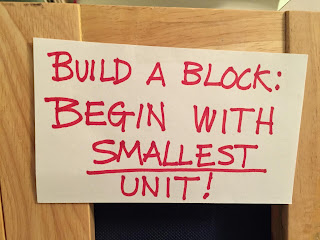Small Units, Broad Application
Small Units, Broad Application
Whether I'm attempting to recreate a pattern without instructions, resizing a block by enlarging or reducing it's dimensions, or puzzling out my own design, once the overall idea is established, it's best to begin a quilt project with the smallest piece. This little reminder has been posted in my sewing room for years,... and sometimes I still forget the wisdom of its advice.
Recently, two encounters reinforced this approach for me.
The first was the Leonardo da Vinci exhibit I wrote about last week. I was struck by a display which explained that the foundation for all of his inventions was the seven mechanisms of "simple machinery": the pulley, wedge, axle, inclined plane, gear, screw and sheave.
If, for instance, Leonardo was commissioned to create a weapon for a patron, he began with the basics and built from there. The commission, - or prompt,- was the genesis for the creative process. The solution to the problem came as he applied what he understood of the basics in new and different ways. (This is a link to the beginning of the four part series:
The second experience happened while we were listening to classical music on a car ride several weeks ago. The radio host played an excerpt of Leonard Bernstein dissecting a Beethoven symphony in a recording of a Young Person's Concert with the New York Philharmonic.
It was fascinating. He pointed out that Beethoven began with a basic triad of notes, repeated several times, before he expanded upon them by experimenting with different musical elements, manipulating certain principles, and building layers with various instruments. You could see how Beethoven's intimate knowledge of the principles of his craft freed him to experiment with the elements of music to create something unique to him. Aside from the musical terminology, the descriptions and language Bernstein used would be familiar and applicable to any creative endeavor.
And that's my point. Beethoven and da Vinci represent genius from two seemingly separate realms, and yet, in these instances, they utilized a similar approach in their creative processes. As much as we might assume an artist, an inventor or engineer, and a musician are very different from one another, it seems they have more in common than we think.
It also goes to show that you can't go wrong if you start with the basic unit.
PS- The New York Philharmonic's Young Person's Concert series with Leonard Bernstein ran from 1958-1972. I was unsuccessful in tracking down the segment mentioned, but there are tons of clips of Bernstein sharing musical insight on line. They would be interesting to the musician and the music fan alike.




Comments
Post a Comment